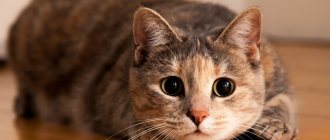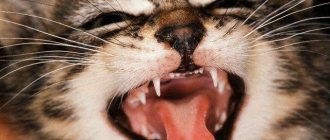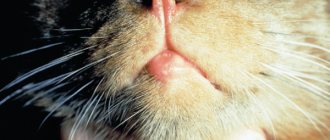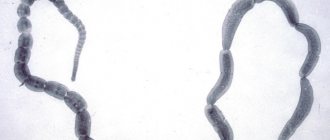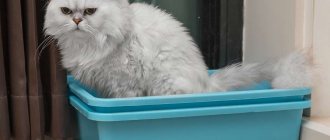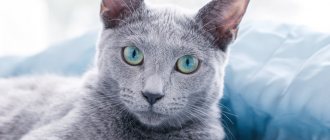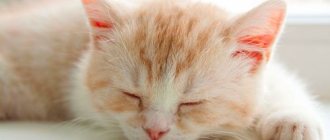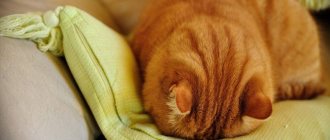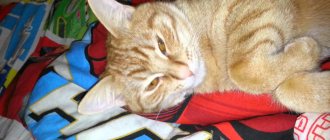What is acne and where does it come from in cats?
Blackheads and acne are plugs that consist of dirt, fat and microbes.
In a healthy animal, the top layers of skin die and are removed from the skin without problems. In a weakened person, they mix with dirt and germs and clog the sebaceous ducts. After bloody wounds, scabs and bald spots will appear that are not covered with hair. Your pet will look ragged and disheveled, but only after you have dealt with the consequences of the disease. Therefore, it is best to start treatment as soon as you notice black dots on your cat’s chin.
First signs of acne
Acne is small nodules (comedones) with a black or white tip that increase in size over time and can fester. Such skin formations are commonly called acne. In the photo, clusters of small comedones look like untidy, dirty areas of skin.
There are several successive stages of acne development:
- inflammation and swelling of the skin area:
- formation of dense subcutaneous nodules;
- maturation of comedones with the appearance of a purulent spot at their top;
- opening of pustules;
- formation of drying crusts.
The disease causes severe itching, the cat constantly scratches the skin, and ulcers (pustules) can form at the site of scratching, which complicate the healing process. If infection gets into the wounds, the cat may develop purulent-necrotic inflammation of the sebaceous glands or hair follicles.
You should not miss the onset of acne in your cat. Treatment should begin as soon as you discover:
- black spots on the chin of a cat;
- redness of the skin of the chin;
- acne began to appear on the ears, nose, lips;
- an itch has appeared, the cat is fiercely scratching its chin with its hind paw, and is nervous;
- The hair around blackheads (blackheads) has thinned out.
It is advisable to immediately take the animal to an appointment with a veterinarian. If the disease is neglected, it can lead to serious complications. and big problems.
The hair follicles will continue to fill with pus, enlarge and become similar to millet grains, and can even reach the size of a pea. Mature acne, with a white or black head, is squeezed out when pressed with purulent contents. They are hot to the touch, the cat scratches them fiercely and becomes aggressive.
The further development of events is the most dangerous for the health of the pet. Microbes get into the scratched areas, and a rather large swelling appears filled with pus. The cat tries to get rid of it, tears it with its claws, opens it up and the infection spreads throughout the body.
After healing, in their place there remain roughly healed bald patches, which are almost completely not covered with hair.
note
This disease is not transmitted from cats to humans. You can stroke and caress the animal without fear.
External manifestation of the disease
The appearance of the rash and the nature of the lesion depend on the form and location of the inflammation. The rash blisters may have a reddish base and a white top. At certain stages of the development of the disease, purulent exudate may form inside the blisters.
It is not recommended to try to squeeze out such rashes. You need to wait until the acne opens up on its own. In order to speed up this process, you can use special ointments with a drying effect.
We suggest you read: Subcutaneous mite in cats symptoms and treatment Acne occurs due to inflammation of the sebaceous glands on the skin
Causes
Not every cat develops acne. Veterinarians believe that the causes of blockage of the sebaceous ducts and their inflammation are:
- Violation of the body's defenses - weakening of the immune system. An unhealthy or old pet has a weak immune system, which causes acne.
- Constant stressful situations, which can be a reclusive life within four walls or too active children's games with an animal.
- Plastic bowls. Plastic is a porous material and microparticles of food remaining in them fall on the cat’s chin and cause inflammatory processes.
- Insufficient hygiene. A cat cannot properly clean its chin on its own.
- Alopecia is a pathology of the hair follicle. Hairless areas are easily infected by microbes.
Attention!
The occurrence of acne can be a signal that your pet has problems with the stomach or liver.
At first, cat acne looks like black dots, tiny spots on the chin near the animal’s mouth. After washing, they do not disappear, but only increase in size. Ulcers form, the cat literally tears them apart, they fester even more and the situation gets worse.
Is it possible to treat acne in cats at home or not? Is it possible to do without the help of a veterinarian? Let's try to understand the causes of acne in cats and find out how to deal with this scourge.
The immediate cause of acne formation is the improper functioning of the subcutaneous glands that produce fat and disruption of the keratinization process. The dead upper layer of the epithelium should exfoliate, slough off, and young cells take its place. If timely exfoliation does not occur, dead cells, like plugs, clog the pores, which leads to the formation of specific subcutaneous nodules of white or black color.
The tendency to develop acne does not depend on the breed or age of the cat. It is believed that factors that provoke the occurrence of acne in a cat may include:
- skin diseases;
- pathologies of the development of sebaceous glands or hair follicles;
- improper metabolism
- reduced immunity;
- hormonal imbalances;
- poor liver function;
- the predominance of fatty foods in the cat’s diet;
- violations of hygiene rules (in particular, infrequent washing of the cat’s feeder or water bowl can cause acne on a cat’s chin).
What problems should you pay attention to?
A cat develops sores on its face for many reasons: infectious, allergic, mechanical, genetic, changes in feeding and others. After determining the cause, the veterinarian prescribes medications designed to combat the disease.
Allergic reaction
Allergies are mainly caused by dietary disturbances, for example, a sudden change in food. It is most susceptible to kittens, animals after illness or surgery, those experiencing stress, and older cats. What they have in common is that the body’s defenses are reduced, which determines the reaction to the allergen. As a result, purulent crusts form near the mouth and on the face. There may be no itching. There may be rashes and redness on the body.
Dermatitis
Dermatitis is an inflammation of the upper layer of skin that occurs as a result of intensive proliferation of bacteria, fungi, or after an insect bite. Older animals, pets with vitamin deficiencies or chronic diseases are most susceptible to it. Sores on the face, ears and neck of a cat with dermatitis appear in the form of crusts. An indicative sign will be itching. The pet's behavior changes. It manifests itself as restlessness and constant scratching. The treatment is complex:
- Finding out the root cause of dermatitis (infection, fungus, bites).
- Treatment with antiseptics (Chlorhexidine, solution of potassium permanganate or boric acid, Argumistin).
- Healing and antimicrobial ointments (Levomekol, Iruksovetin, Streptocide ointment 10%, Baxin ointment).
- Vitamin complexes to improve immunity.
- Antibiotics (Cefotoxime, Clindamycin) – for bacterial infections.
- Antifungal drugs (Miconazole, Nizoral).
There are many causes of dermatitis, so a veterinarian should prescribe medications, dosages and courses of treatment. Self-therapy can lead to complications.
Ringworm
Ringworm in cats is a fungal disease. It mainly affects kittens and pets who have suffered a serious illness due to weakened immunity. Symptoms:
- hair loss in patches on the face, paws and tail;
- bald spots are red and peeling is observed;
- sometimes purulent blisters and scales appear in the center.
Therapeutic measures consist of treating the affected areas with antifungal ointments after wiping with antiseptics. If the process is severe, antibacterial agents and injections are prescribed.
The disease is characterized by the appearance of acne on the chin. Factors that provoke their occurrence are lack of hygiene, stress, infections, inflammation of the sebaceous glands. The lesion is observed in the form of black or white dots and slight baldness. If acne is not cured, the spots will turn into ulcers. This is dangerous due to the development of a secondary infection.
Therapeutic procedures consist of treatment with antiseptics (Miramistin, Chlorhexidine, boric acid solution) and antiseborrheic agents (tar soap). If a bacterial infection or inflammation occurs, antibiotics are prescribed.
Demodicosis
Disorders caused by parasitic mites appear as small bumps on the cat's body that ooze a white fluid when squeezed. At the same time, the pet is constantly itching. Sores on a cat's face - rashes, baldness, red crusts, redness.
Treatment is extremely necessary, since demodicosis often leads to the death of the pet. Therapeutic procedures: treatment of affected areas, acaricidal preparations in the form of tablets, drops, shampoos (Bars, Advocate, Comfortis), vitamin complexes.
Sores appear in animals for many reasons. You should not self-medicate. A timely visit to a specialist will save your pet’s life.
Diagnostics
To make an accurate diagnosis, the veterinarian will conduct an external examination of your pet and prescribe a series of laboratory tests. Acne has a very typical appearance.
READ Method of performing cat sterilization surgery
But it should be understood that acne on an animal’s chin may be a sign of another disease that has similar symptoms:
- tumors of the sebaceous glands;
- demodicosis or scabies (skin lesions caused by microscopic mites);
- dermatophytosis (lichen, a disease caused by the dermatophyte fungi Microsporum canis, Microsporum gypseum and Trichophyton);
- eosinophilic granuloma and other skin diseases of allergic origin;
- leprosy (a skin disease caused by the bacteria Mycobaterium lepraemurium);
- ectoparasite eggs laid on the surface of the skin (fleas, lice, lice);
- insect bites.
To differentiate acne from other pathologies, the cat is given a general and serological blood test, this makes it possible to identify the possible pathogen (bacteria, viruses, protozoa). A bacteriological examination of a tissue sample from the affected areas of the skin is also carried out. If a fungus is suspected, a Wood's UV lamp can be used to clarify the diagnosis.
Treatment options
It is worth noting that this disease is extremely rare in street cats. Experts are of the opinion that the appearance of a pet depends entirely on the quality of care.
ATTENTION!
Black dots form if the sebaceous glands do not work correctly or the metabolic process is disrupted. You can be sure that the disease is not transmitted to humans or other animals. In principle, it does not cause any harm in an unused state.
If you want to play it safe, you should visit a veterinarian. After the specialist examines the pet, he will prescribe the necessary tests and skin scrapings.
And. This is the only way to establish an accurate diagnosis. The following skin diseases may occur with similar symptoms:
- demodicosis;
- allergy;
- fungal diseases of cats;
- leprosy;
- presence of fleas;
- tumors.
After identifying the problem, the specialist must prescribe the necessary treatment. Depending on the stage of the disease, different medications and methods of combating acne and other diseases may be prescribed. Antiseptics may also be prescribed; it happens that the doctor prescribes antibiotics.
When treating the affected areas, you need to remove all existing contaminants, blood, if any. To do this, you can use hydrogen peroxide or chlorhexidine.
Usually the product is applied to a cotton swab, and then the wound is treated with it. If necessary, you can trim the hair on the chin. Usually the treatment complex includes:
- tar soap and tar shampoo,
- medicated shampoos,
- antiseptics,
- pertukan,
- vitamin complexes.
How to treat acne in a cat
If a cat constantly has black spots on its chin, then it definitely needs to be treated. Regular pimples and abscesses on a cat's chin cause severe discomfort and can lead to the pet starting to refuse food.
The constant appearance of blackheads on the chin requires immediate treatment.
Acne treatment can be either local or complex. But the main thing to remember is what you should never do:
- You should not squeeze out purulent pimples on a cat’s chin.
- Do not use a brush with sharp teeth to comb fur.
- If the doctor has prescribed a topical treatment, then you should not apply the medicine to the entire cat. Healthy areas of the skin may be damaged by medications and irritation may occur.
- Do not skip regular procedures for drying the sebaceous glands. Otherwise, the development of the disease will begin again.
- Do not apply more medicine to pimples than the veterinarian prescribed. Many owners think that acne can be cured faster this way. But that's not true. Too much ointment on the wound will prevent oxygen from entering the wound. And from this, the condition of the wounds on the chin may worsen.
Do not use a brush with sharp teeth to comb fur.
Take care of the fur and bathe your cat more often.
Many owners begin self-treatment, due to the fact that the doctor can prescribe expensive drugs and ointments.
In the initial stages, it is enough to shave the hair from the chin and treat the affected area with soap, tar shampoo or hydrogen peroxide. After treating the skin, it should be lubricated with salicylic acid. Next, an ointment with a moisturizing and bactericidal effect is applied. Such actions are enough to cleanse the skin of blackheads and pimples.
At the initial stage of the disease, it is enough to treat the cat’s chin with hydrogen peroxide.
Pustules
If there are pustules on the affected area, they should be treated with the antibiotic Bactroban. This drug is for external application to open purulent wounds in cats. In combination with an antibiotic, ointments containing vitamin A are suitable.
The antibiotic Bactroban should be used if pustules are present.
In the final stages of acne, the cat's chin becomes very inflamed.
It will include not only taking medications, but also a certain diet for the pet. During treatment, the cat should not eat anything fatty. No fatty foods or other unhealthy food from the owner’s table.
The first step is to visit a veterinary clinic. There they will take a scraping from the problem area and conduct a visual inspection. And only then will adequate treatment be prescribed. Acne is easily confused with worm and flea eggs. Black dots on a cat's chin can be both an allergy and demadecosis. Only a veterinarian can tell for sure. Next, you will receive recommendations that you will follow when treating acne in your cat.
You will have to very carefully shave the hair on the affected area, without tearing off the blackheads. They cannot be injured. You can use an ordinary razor. This is done so that acne is better visible, so it will be easier to process and treat it.
Skin covered with pimples should be washed with anti-acne shampoo. The following components are desirable in its composition:
- sulfur;
- salicylic acid;
- ethyl lactate;
- benzoyl peroxide.
Such ones as Lactaderm, Doctor are perfect. These products not only normalize the functioning of the sebaceous glands, but also slightly dry the skin. We need them to soften acne and make further treatment more effective.
Cleansers are applied with a swab only to infected areas. Their remains are removed with a damp soft towel and a dry towel is applied to dry the treated area.
These products should be used no more than twice a week
Then you need to treat the sore areas with salicylic acid, carefully wiping them with cotton swabs.
Attention
Try to treat salicylic only on diseased areas so as not to dry out healthy skin and complicate the situation.
Now comes the turn of the healing agents. We use those recommended by the doctor. And we will list those that in any case will not harm, if there are no objections from the veterinarian specifically for your case.
- Belosalik cream dries out pimples and removes ulcers. It is applied with a cotton swab in a thin layer. You need to make sure that the animal is not able to lick the ointment, otherwise this can lead to disastrous results.
- Also suitable for purulent pimples is the antibiotic Bactroban and ointments containing vitamin A.
- Mupirocin in gel or ointment form. It is bought in regular pharmacies. Should be used no more than once a day.
READ Hypoallergenic cats are the best pets for people with allergies
If the pet’s condition is determined to be the last stage of acne, then the doctor prescribes a comprehensive treatment, including antibiotics.
All types and methods of treatment are used with a properly selected diet. During the entire treatment period, the cat cannot be fed with fatty foods, and any additional feeding from our owner’s table is also excluded.
Advice after
Do not be lazy to treat diseased areas with hydrogen peroxide, calendula tincture and other antiseptics. Tetracycline or erythromycin ointment is also good for treating pimples.
Folk remedies
It is useful to steam acne by applying warm tampons soaked in chamomile infusion. Then the steamed areas are wiped with salicylic acid. This folk remedy can soften and disinfect cat acne every day.
A decoction of celandine helps a lot, which is prepared as follows: 1 tablespoon of dry herb is poured with one and a half cups of water. Everything is brought to a boil and simmers over low heat for no more than 5 minutes. Then everything is infused, filtered, and cooled. Use for lotions, rinsing, cleansing.
If you have a pumpkin, you can wipe the affected areas with a piece you just cut from it. It both cleans and heals.
Symptoms of sores on the chin
A single manifestation of acne in a place such as the chin does not always need to be treated. Often the disease goes away on its own in cats and cats, almost asymptomatically and does not bother the animal. But it may happen again. If it occurs frequently, you should contact your veterinarian.
Symptoms:
- redness and swelling of the skin;
- the appearance of black dots similar to dirt on the animal’s fur, the number of which gradually increases;
- swollen lower jaw;
- the appearance of ulcers that cause itching and irritation in cats;
- at the last stage of the disease, blood sores appear on the combed chin, and hair falls out.
Treatment
Treatment methods for acne in cats depend on the severity of the disease. If there are few comedones and they do not fester, the use of topical (external) preparations is sufficient. In case of advanced disease, medications are used for internal use.
Attention! Only a doctor can determine how to treat acne in a cat. Self-medication is dangerous. Under no circumstances should you squeeze out even single comedones that have formed on a cat’s chin.
The local therapy regimen is usually as follows:
- Areas of skin affected by acne are treated with antiseptic agents several times a day. This can be salicylic alcohol, hydrogen peroxide, alcohol tincture of calendula. There are special skin antiseptics - Miramistin, Chlorhexidine, Percutan. You can use tar soap or medicinal shampoos from Hartz and Bifar.
- When purulent crusts appear, the affected areas are treated with a solution of the antibiotic Bactroban (Mupirocin).
- In case of severe inflammation, a course of treatment with prednisolone ointment may be prescribed.
- Nourishing ointments are rubbed into the skin, disinfected with an antiseptic. They dry out comedones and prevent the formation of pustules. At a veterinary pharmacy you can buy Yam ointment, Levomekol, salicylic, zinc, sulfur, tetracycline ointments or Liniment synthomycin.
The ointment is applied to the affected area of skin in a thin layer and left for about half an hour, after which the residue is carefully removed with a cotton swab. The cat should not be allowed to lick the medicine.
If the disease is advanced, the veterinarian may prescribe the cat a two-week course of treatment with systemic antibiotics. The most commonly used are Amoxicillin, Enrofloxacin or drugs from the cephalosporin group: Cefazolin, Cefuroxime, Cefotaxime, Cefepime. They are given to the cat in tablets or administered intramuscularly, the dose is determined by the veterinarian.
The use of folk remedies can give good results in the treatment of acne. Among the most popular recipes:
- Celandine decoction. Pour 2 tablespoons of herbs into 0.5 liters of water, bring to a boil, leave and cool. Use the strained broth for lotions.
- Chamomile decoction with furatsilin. Pour a tablespoon of chamomile flowers into a glass of boiling water, leave for half an hour covered, then strain. Crush 2 tablets of furatsilin, mix with 3 tablespoons of chamomile infusion. Apply this mixture to the rash areas several times a day.
- Yarrow decoction. A tablespoon of yarrow flowers is brewed in a glass of water; the resulting decoction is carefully wiped over the affected areas of the skin, without damaging the comedones.
A prerequisite for complex acne therapy is diet: high-fat foods are excluded from the cat’s diet until acne manifestations completely disappear.
What you can do at home
There are a number of specific rules for self-treatment of skin diseases in pets. When the first symptoms of acne appear, you should pay increased attention to your pet. In order to reduce the severity of itching, it is necessary to use special shampoos while bathing. In order to dry the rash blisters, you can use tar soap or a three percent solution of hydrogen peroxide.
In order to facilitate the application of medications to areas of inflammation, you need to carefully shave the hair on the affected areas of the body. In the presence of keratinized tissue, special keratolytic compounds are used. Salicylic acid can be used for this purpose. In combination with this medication, experts recommend using various local drugs, the action of which is aimed at regenerating damaged tissues and normalizing intercellular metabolism.
When talking about how to treat cat chin acne at home, it is important to mention that human scrubs and lotions should not be used to treat blackheads. It is also prohibited to treat acne in pets with antibacterial drugs. Antibiotics are used only in cases of severe forms of the disease, when the rash spreads throughout the pet's body.
Even taking into account that the diagnosis made independently will be correct, the use of many medications can negatively affect the animal’s well-being. In addition, in the absence of the necessary knowledge, it is very difficult to choose the right dosage.
Additional Tips
- The cat's diet should be replenished with fiber and vitamins.
- The plastic bowl needs to be replaced with a metal one.
- Make sure that your pet does not lick the ointments and medications that you treat him with. Swaddle the cat so that it does not flutter and hold it in your hands after applying the medicine for at least 20-30 minutes to allow the medicine to be absorbed and prevent it from being licked off immediately after treatment.
All of the above medical procedures can be carried out only after you have visited a veterinary hospital and your pet has been examined by a doctor. A visit to the veterinarian will save your pet from complications.
You can quickly restore your cat’s health, and save yourself from unnecessary problems if you treated the animal incorrectly.
Your veterinarian may ask for blood and urine tests to help determine the cause of your acne. Do it. At the initial stage, any disease is easier to treat and goes away without a trace.
If a cat has a hormonal imbalance, then she will be prescribed a comprehensive treatment. Sometimes the situation is more serious, and simply using ointments and creams will not help the animal.
Causes of lumps on the chin of a pet
Every owner worries about the health of his cat and tries to prevent situations where the life or health of the pet is threatened. But it is simply impossible to always control and protect an animal. Therefore, sometimes situations occur that lead to a swollen cat’s chin. The reasons for the appearance of various bumps include
:
- Acne
. They can also be called blackheads. Inflammatory processes occur as a result of clogged pores on the pet’s skin. In addition, anke can be caused by poor-quality food or dishes of the animal. A plastic plate can absorb various germs that are not washed off with water. Here they are actively developing. The pet will constantly touch the dangerous place with the lower jaw, which will lead to the development of acne or blackheads. If treatment is not promptly addressed, a lump with abscesses or suppuration will appear on the chin. - Insect bites
. Usually they are bees or gadflies. In this case, the owner must give an antihistamine to his cat. - Allergy
. It is definitely worth analyzing what could have led to its formation and giving your pet allergy medication. This must be done quickly so that the animal does not get worse, as the reaction may go lower. For example, the neck. - Abscess
. Most often it occurs as a result of an insect bite. Accompanied by elevated temperature, apathy, and lethargic state of the animal. In addition, the abscess causes severe pain when touched, as well as the discharge of pus with ichor. Only a veterinarian can save a cat or cat from this disease. Moreover, this must be done surgically. - Dental diseases
. - Neoplasms of various types
.
It is better not to wait for a cat with a lump on the chin to get worse, but to immediately go to the vet when it is detected. He will examine the sick animal, make a diagnosis, according to which the correct treatment will be prescribed.
VETERINARIAN CONSULTATION REQUIRED. INFORMATION FOR INFORMATION ONLY. Administration
Unsightly sores and black spots on a cat's chin are a clear sign of feline acne, a disease that affects many pets. Acne causes discomfort, and if left untreated, leads to serious consequences: a beautiful pussy becomes a shabby little animal, so you should not put off a visit to the veterinarian.
Prevention
Measures to prevent cat acne are very simple. First of all, you need to take care of the cleanliness of the cat's dishes and the hygiene of the cat itself. Feeders and drinkers should be washed every day. It is better to purchase bowls for food and water that are ceramic or metal. Bacteria easily collect in plastic dishes, as they have fairly large pores. If your cat gets its chin dirty while eating, wipe it with a clean, damp cloth; you can use an antiseptic solution instead of water.
If your cat is prone to skin rashes such as acne, limit fatty foods in her diet. A complete and varied diet, containing a sufficient amount of nutrients, vitamins and microelements, will help strengthen the animal’s immunity so that its body can better cope with potential diseases.
READ Pit bull terrier named Hector got lost in the Istra forest
Preventive measures against acne
To prevent the appearance or development of purulent acne, follow simple rules:
- After eating, clean your pet's chin and face with a damp cloth; Wash water and food bowls every day;
- carry out water procedures regularly; hygiene plays an important role in the prevention of many diseases;
- if the slightest pimples appear on the chin, immediately contact a veterinarian so as not to trigger the disease;
- monitor your pet's diet;
Cats do not need to be given hormonal pills. It would be best to sterilize your cat once, which will save her from serious problems with health problems and there will be no risk that you will irreversibly upset the hormonal balance in your pet’s body.
If you do not plan to breed offspring, sterilize the animal. In sterilized animals, there are almost no cases of black spots on the chin, which we define as acne in cats.
Comedones squeezed out by the cat's owner.
Next, small blackheads appear, called comedones, have the shape of a cone with a black top, and gradually increase in size. The tops of the cones may also be white. This happens because the plug is deep inside, without access to air.
The lower jaw swells. In advanced or severe forms of the disease, pustules and skin nodules appear on the affected area. Pain and itching appear. The cat is worried, shows nervousness, aggression, and scratches the chin area. On the inflamed area, purulent or bloody crusts are released. The fur falls out.
Establishing diagnosis
The exact clinical picture will be determined by a veterinarian at the clinic. After a visual examination, the doctor prescribes a laboratory examination. The pet's skin is scraped, a test is taken to detect a fungal infection, and less often a biopsy is performed.
Allergies have similar symptoms to ACNE.
The necessary studies are carried out to exclude similar diseases: demodicosis, dermatophytosis, allergies, eosinophilic granuloma, scabies.
Treatment
Treatment is carried out comprehensively, including local treatment, oral administration, injections, and diet. For local processing use:
- tar soap;
- medicated shampoo against seborrhea;
- tar shampoo;
- antiseptic solutions - chlorhexidine, miramistin;
- cotton-gauze bandage with calendula tincture;
- percutane.
A jar of hydrogen peroxide.
The use of hydrogen peroxide, salicylic alcohol, and iodine is recommended with caution for treatment. Percutan is prescribed twice a day until symptoms disappear completely. For purulent and bloody crusts, the use of external antibiotics - mupirocin, bactroban - is indicated.
Antibiotics are prescribed if there is a secondary infection. Severe inflammation is treated with a course of corticosteroids - prednisolone. It is necessary for treatment to prescribe vitamin supplements in the form of omega-3 and omega-6 acids. The animal is kept on a low-fat diet.
A neglected case.
Additionally, you can use a solution of chlorophyllipt or clotrimazole. Apply directly to acne. After treatment with the above solutions, apply sulfur ointment without rubbing. Treatment at home requires compliance with some precautionary rules. Under no circumstances should pimples be squeezed; they must go through the process of maturation and opening on their own.
Frequent wetting will cause the skin to dry out and, as a result, cause a chemical burn. Use antiseptics such as alcohol, iodine, brilliant green with extreme caution. Frequent use will lead to a larger area of localization of the rash.
Zelenka can be replaced with an aqueous solution of methylene blue, which will remove irritation. Be sure to apply local preparations in a thin layer. In some cases it is necessary to interrupt treatment. Such cases include situations in which skin irritation increases. Even with positive results of treatment, you should immediately interrupt the therapy and allow the irritation to subside, ensuring all measures for the healing of the epidermis.
When the area affected by acne only increases and does not decrease. It is worth stopping intensive use of drugs for several days. After some time, resume treatment, but use other medications.
The effect in the treatment of acne is provided by folk remedies.
Tincture of calendula.
Celandine grass is used for lotions. You need to take four tablespoons of chopped herbs, six glasses of water, and boil for five minutes. Cool, strain. Lubricate the sore spot and make a lotion.
Fresh pumpkin is useful to use. You can apply a freshly cut piece to the affected area three times a day and lubricate it. Keep it for 3-5 minutes.
One teaspoon of crushed yarrow herb is poured into a glass of water and brewed. The decoction, strained and cooled to room temperature, is used to treat the area affected by the rash.
The set of preventive measures includes several requirements available to everyone. It is unacceptable to use plastic dishes to feed the animal. Many pets are sensitive to chemicals, which can cause allergies and, as a result, acne. Over time, scratches form on the plastic, where food debris gets trapped, creating a favorable environment for the proliferation of pathogens.
Bacterial infection on the chin.
It is necessary to keep the animal's dishes clean. Otherwise, there is a risk of infection. Your cat's water should be changed at least once or twice a day. Water must be clean, fresh, filtered.
Chin area
If a cat has had ACNE, then blackheads may appear again due to the risk of relapse. In such cases, it is recommended to treat the wool with antiseptic solutions.
Animals that have experienced a single case of acne are prone to its repetition and relapses, so the risk area should be treated with antiseptic solutions after eating.
Do not allow the cat's body to weaken. A balanced diet containing nutrients rich in vitamins, microelements, omega-3, omega-6 fatty acids.
